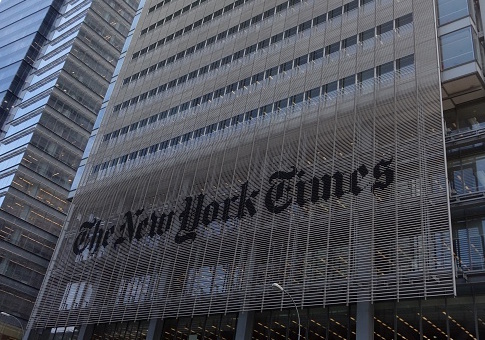The New York Times apologized for the first time Sunday after publishing an anti-semitic cartoon Thursday.
"We are deeply sorry for the publication of an anti-Semitic political cartoon last Thursday in the print edition of The New York Times," a statement from the Gray Lady read.
The cartoon featured Israeli Prime Minister Benjamin Netanyahu, portrayed as a dachshund with a Star of David collar, leading President Donald Trump, portrayed as a blind man wearing a Jewish yarmulke.
"Such imagery is always dangerous," the paper said, "and at a time when anti-Semitism is on the rise worldwide, it's all the more unacceptable."
We apologize for the anti-Semitic cartoon we published. Here’s our statement. pic.twitter.com/nifZahutpO
— New York Times Opinion (@nytopinion) April 28, 2019
The New York Times had previously said it would be deleting the cartoon, but without apology."The image was offensive, and it was an error of judgement to publish it," the early statement said.
An Editors' Note to appear in Monday’s international edition. pic.twitter.com/1rl2vXoTB3
— New York Times Opinion (@nytopinion) April 27, 2019
Lawmakers on both sides had quickly condemned the cartoon and non-apology. Rep. Dan Crenshaw (R., Tex.) called it a "weak-at-best apology." He accused the political left of having "normalized anti-Semitism under the guise of criticizing US-Israel foreign policy. It is radicalizing people," he said.
Vice President Mike Pence retweeted the initial non-apology to offer his own rebuke. "We stand with Israel and we condemn antisemitism in ALL its forms, including @nytimes political cartoons," he wrote.
New York Times opinion columnist Brett Stephens lambasted the paper for "purveying" anti-Semitism.
In an op-ed Sunday, Stephens remarked that the paper, hyper-sensitive about all other minority groups, had a blind spot for Jew-hatred. He wrote:
Imagine, for instance, if the dog on a leash in the image hadn't been the Israeli prime minister but instead a prominent woman such as Nancy Pelosi, a person of color such as John Lewis, or a Muslim such as Ilhan Omar. Would that have gone unnoticed by either the wire service that provides the Times with images or the editor who, even if he were working in haste, selected it?
The question answers itself. And it raises a follow-on: How have even the most blatant expressions of anti-Semitism become almost undetectable to editors who think it's part of their job to stand up to bigotry?
The reason is the almost torrential criticism of Israel and the mainstreaming of anti-Zionism, including by this paper, which has become so common that people have been desensitized to its inherent bigotry.
The cartoon is the work of Portuguese cartoonist António Moreira Antunes. He first published it in a Lisbon paper. Antunes has previously compared Israeli soldiers to Nazis, and drawn several cartoons taking aim at Israel.
As Stephens noted in his op-ed, the cartoon appearing in this particular is apt. The self-styled paper of record "mostly buried news about the Holocaust," during the Second World War. Today, its "overall approach toward the Jewish state tends to range, with some notable exceptions, from tut-tutting disappointment to thunderous condemnation."
The New York Times admitted Sunday it chose the image from a menu peppered with racist cartoons.
According to a story published in the New York Times Sunday, the image came from an automated feed of cartoons submitted for inclusion in the international edition of the paper. According to the story, editors for the New York Times need to "sporadically review the feed and remove work that is biased or racist."
The provider of that menu defended the image, but said he respected the decision to remove it from circulation. "The cartoon in question was viewed as political commentary," he said. "However, we understand the decision to remove it from the website."
